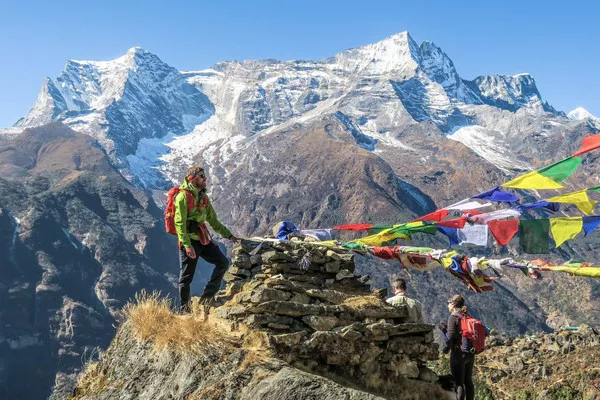Nestled within the grandeur of the Himalayas lies one of the world’s most iconic trekking destinations—the Everest Base Camp Trek. This remarkable adventure offers intrepid explorers a chance to traverse stunning landscapes, witness breathtaking panoramas, and immerse themselves in the rich Sherpa culture of Nepal. In this article, we delve into the intricacies of this renowned trekking route, uncovering the allure that draws thousands of adventurers each year.
Embarking on the Everest Base Camp Trek
The Everest Base Camp Trek is a multi-day journey that leads trekkers through the heart of the Khumbu region in Nepal. Starting from Lukla, a small town with a bustling airstrip often described as one of the world’s most dangerous, the trek winds its way through picturesque Sherpa villages, dense rhododendron forests, and high-altitude landscapes. The ultimate goal? To reach the base camp of Mount Everest, the tallest peak on Earth, standing at a breathtaking altitude of 5,364 meters (17,598 feet).
The Route: A Path to Adventure
The trek to Everest Base Camp typically spans around 12-14 days, allowing ample time for acclimatization and exploration along the way. The route begins with a scenic flight from Kathmandu to Lukla, where the trekking adventure truly commences. From Lukla, trekkers embark on a path that gradually ascends through vibrant Sherpa villages like Namche Bazaar, the gateway to the Khumbu region.
As the trail winds higher into the mountains, the landscape transitions from lush forests to alpine terrain, dotted with prayer flags and mani stones—a testament to the rich Buddhist heritage of the region. Along the way, trekkers pass through iconic waypoints such as Tengboche Monastery, a serene Buddhist monastery with panoramic views of Everest and its neighboring peaks.
Challenges and Rewards: Nature’s Bounty
The Everest Base Camp Trek is as much a test of endurance as it is an opportunity for unparalleled natural beauty. Trekkers face the challenges of high altitude, with each day’s ascent bringing thinner air and cooler temperatures. Proper acclimatization is crucial, allowing the body to adapt gradually to the reduced oxygen levels.
Yet, the rewards of this journey are abundant. Majestic vistas unfold with each step—Ama Dablam’s towering peak, the Khumbu Icefall, and, of course, the awe-inspiring sight of Mount Everest herself as trekkers approach base camp. The camaraderie among fellow trekkers and the warm hospitality of the Sherpa people add to the experience, creating memories that last a lifetime.
Cultural Encounters: Sherpa Way of Life
A highlight of the Everest Base Camp Trek is the opportunity to immerse oneself in Sherpa culture. The Sherpas, known for their resilience and mountaineering prowess, have inhabited this region for centuries. Trekkers encounter traditional Sherpa villages like Khumjung and Pangboche, where colorful prayer flags flutter against the backdrop of snow-capped peaks.
Visiting monasteries and interacting with local Sherpa families provide insight into their way of life and spiritual beliefs. Trekkers may join in cultural ceremonies or simply enjoy a warm cup of butter tea—a staple of Sherpa hospitality—amidst the stunning Himalayan scenery.
Logistics and Preparation
Embarking on the Everest Base Camp Trek requires careful planning and preparation. Trekkers should be in good physical condition, with prior trekking experience recommended due to the strenuous nature of the journey. Adequate gear, including sturdy trekking boots, warm clothing, and a reliable backpack, is essential for the trek’s duration.
While the trek is feasible for most individuals with proper training and guidance, it’s important to consult with experienced guides or tour operators familiar with the region. They can provide invaluable advice on itinerary planning, altitude acclimatization, and safety protocols.
Preserving the Himalayan Environment
Responsible trekking practices are essential to preserving the fragile Himalayan environment. Trekkers are encouraged to adhere to “leave no trace” principles, minimizing waste and respecting local customs. Many tour operators support sustainable trekking initiatives, promoting eco-friendly practices and contributing to the well-being of local communities.
Conclusion
The Everest Base Camp Trek is more than a physical journey; it’s an odyssey of discovery and self-reflection. From the thrill of conquering high mountain passes to the warmth of Sherpa hospitality, every step on this trek is a testament to the human spirit and the allure of the world’s highest peaks.
For those seeking adventure, cultural immersion, and unforgettable vistas, the Everest Base Camp Trek stands as a pinnacle of trekking experiences—a chance to touch the sky and leave footprints on the roof of the world. So lace up your boots, pack your sense of wonder, and prepare for the journey of a lifetime amidst the grandeur of the Himalayas.

